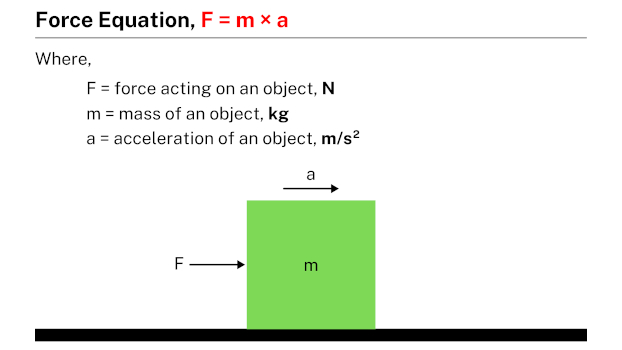In physics, force is described as a push or pull[1][2] that one object exerts on another. It represents an interaction capable of altering the motion of the object upon which it acts.[3] Forces are evident whenever two objects interact with one another.[4]
Examples
Toy train

When a toy train, connected to a thread, is pulled by hand while resting on the floor, an interaction between the hand and the thread generates a force that propels the toy train forward. In this scenario, the hand exerts a force on the toy train to initiate its movement.
Ball

When someone kicks a ball with their leg, a force is applied to the ball, propelling it forward. This force originates from the interaction between the leg and the ball. As the foot makes contact with the ball, it transfers energy to the ball, resulting in the application of force. Thus, when a ball is kicked with the leg, the leg exerts force on the ball, initiating its movement.
Glass of water

Imagine a glass of water resting on a desk. When a hand reaches out to pick up the glass, a force is applied to it. The force, originating from the hand, interacts with the glass of water. As a result, the glass experiences an upward force, enabling it to be lifted and moved. In this scenario, the hand’s force acts on the glass, facilitating its displacement from the desk.
Horse-drawn vehicle

When a horse pulls a cart, an interaction between the horse and the cart generates a force that drives the cart forward. This force, applied by the horse, is what enables the cart to move along its path.
Punching bag

When striking a punching bag with a fist, a force is exerted on the bag. This force originates from the interaction between the fist and the bag. As the fist makes contact with the bag, it transfers energy to the bag, resulting in the application of force. This force causes the bag to move and absorb the impact of the punch.
Door

When opening or closing a door using a key, a force is applied to the key. This force is exerted by the hand turning the key in the lock. As the key turns, it interacts with the locking mechanism of the door, allowing the door to be unlocked and opened, or locked and closed, depending on the direction of the turn. This force is essential for operating the door and controlling its movement.
Trolley

When pushing a trolley by hand, a force is applied to the trolley. This force originates from the interaction between the hand and the trolley. As the hand exerts pressure against the trolley, it transfers energy to the trolley, resulting in its movement. This force is what propels the trolley forward or backward, depending on the direction of the push.
Dumbbell

When lifting a dumbbell by hand, a force is exerted on the dumbbell. This force is generated by the muscles in the hand and arm. As the muscles contract, they apply pressure to the dumbbell, causing it to move upward against the force of gravity. This force is necessary to overcome the weight of the dumbbell and lift it from its resting position.
Window

In a typical situation, opening a window with a hand involves the application of force. When a window is opened using a hand, an interaction occurs between the hand and the window, resulting in a force being exerted. It is a general principle that when two objects interact, a force is present. Hence, when a window is opened or closed with a hand, a force from the hand acts upon the window.
Equation

The force equation states that the force (F) acting on an object is equal to the product of its mass (m) and acceleration (a). Mathematically represented as F = m × a, this equation is used to calculate the amount of force exerted on an object.
Practice problems
Problem #1
Determine the force required to accelerate a 5 kg box at the rate of 10 m/s2.
Solution
Given data:
- Force acting on a box, F = ?
- Mass of a box, m = 5 kg
- Acceleration of a box, a = 10 m/s2
Applying the formula:
- F = m × a
- F = 5 × 10
- F = 50 N
Therefore, the force required to accelerate a 5 kg box at the rate of 10 m/s2 is 50 N.
Problem #2
What is the force acting on a football with a mass of 450 grams when it is accelerating at a rate of 20 m/s2?
Solution
Given data:
- Force acting on a football, F = ?
- Mass of a football, m = 450 gm = 0.45 kg
- Acceleration of a football, a = 20 m/s2
Applying the formula:
- F = m × a
- F = 0.45 × 20
- F = 9 N
Therefore, the force acting on a football is 9 N.
Problem #3
Calculate the force acting on a 2 kg bowling ball that is experiencing an acceleration of 18 m/s2.
Solution
Given data:
- Force acting on a bowling ball, F = ?
- Mass of a bowling ball, m = 2 kg
- Acceleration of a bowling ball, a = 18 m/s2
Applying the formula:
- F = m × a
- F = 2 × 18
- F = 36 N
Therefore, the value of force acting on a bowling ball is 36 N.
Problem #4
If a rubber tire with a mass of 1 kg accelerates at a rate of 6 m/s2, what is the magnitude of the force acting on it?
Solution
Given data:
- Mass of a rubber tire, m = 1 kg
- Acceleration of a rubber tire, a = 6 m/s2
- Force acting on a rubber tire, F = ?
Applying the formula:
- F = m × a
- F = 1 × 6
- F = 6 N
Therefore, the value of force acting on a rubber tire is 6 N.
More topics
References
External links
- Types of Forces: Explanation, Review, and Examples – Albert
- Types of Forces – The Physics Classroom
- Force – Wikipedia
- Force in Physics | Definition, Equation & Types – Study.com
- The Meaning of Force – The Physics Classroom
- Force Definition and Examples (Science) – ThoughtCo
- Force Definition & Meaning – Merriam-Webster
- Force – Maths Is Fun
- What are some examples of forces? – Socratic
Deep
Learnool.com was founded by Deep Rana, who is a mechanical engineer by profession and a blogger by passion. He has a good conceptual knowledge on different educational topics and he provides the same on this website. He loves to learn something new everyday and believes that the best utilization of free time is developing a new skill.
